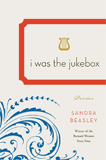Review by Kristin Black
W.W. Norton & Company, Inc.
500 Fifth Avenue
New York, NY 10110 USA
ISBN 978-0-393-07651-6
2010, 90 pp., $24.95
www.wwnorton.com
You could be forgiven if you let the clever conceits in Sandra Beasley’s latest collection distract you. Or if you spent the whole 90 pages identifying with the cast of slightly neurotic speakers—an orchid who refuses to be “another table pet,” a lonely eggplant walking the “thin line / between love and bribery in a bar.” After all, the pithy neatness, sly humor and unexpected tenderness in I Was the Jukebox make each of these poems exceedingly good company. The real strength of this new collection, though, is structural, which is why it would be a mistake to read these lovely pieces individually. Instead, I recommend devouring as many as you can in one sitting—both because their liveliness owes something to their placement within the collection as a whole, and because the collection’s unity owes something to the rigors of the sestina, a tortuously demanding poetic form that has become Beasley’s trademark exercise (but more on that in a minute).
For now, let’s think about hyperlinks, about the rapid cuts between disparate subjects, the tenuous connections via single words or phrases. I was the Jukebox is at least partially Wikipedic in structure, replicating both the subject-definition form of the entries and the energy of moving between them. “Oxidation” is “ascendant valence” and “reactant loss,” a “ slow // striptease of protein.” Genetic material becomes “a simple whip graft, the way / a pear tree is bullied into fruit.” A single image in one poem inspires the title and content of the next, as when, in “Orchis Speaks,” the “dream[s] of Greece” open to “Another Failed Poem about the Greeks.” The origami folds in “Japanese Water Bomb” introduce the iconic origami crane on the flipside of the page. The semi-aquatic capybara that is the subject of “Unit of Measure” is the forerunner of that other semi-aquatic mammal—the platypus—the trundling speaker of the next poem. In fact, reading the full book in a single sitting is a bit like the compulsive pleasure of browsing Wikipedia for an hour, one entry’s shared word the justification for the next.
Which brings us to the sestina, a form whose logic hinges on the six shared words in every stanza. There are three of the 39-line poems in I was the Jukebox, inventively twisty pieces whose obsessive repetitions tend to sneak up on you. Beasley has written extensively about the inspiration she finds in the tight, recursive choreography of the form, the way the iterations “dictate their own narrative path.” Her sestina practice has also given her an agility with slant rhyme, unexpected inversions, and inflected forms—a noun torqued into a verb here or grafted with an adjectival ending there. In “Returning to the Land of 1,000 Dances,” the sestina in the first section of the book, we get, “I’m no Fred, you’re no Ginger,” “Your boots weren’t made for waltzing gingerly,” and “A house of bread and ginger.” This is the kind of freewheeling imagery that can only come from being forced to use the word “ginger” seven times in the span of two pages. And it’s the kind of imagery that requires the strong anchor of vertical alignment along the poem’s right side to hold it together—much the same way the chasing themes of a contrapuntal composition need moments of intersection to hold their timing.
This musical analogy is one Beasley references in “Fugue,” a surreal dream of a poem that seems to be held together primarily by its syntactical repetitions. “Unit of Measure,” which was chosen for this year’s Best American Poetry collection, functions on the same kind of insistent reiteration at the front- and back-end of every sentence: “Everyone is lesser than or greater than the capybara. / Everything is taller or shorter than the capybara. / Everything is mistaken for a Brazilian dance craze / more or less frequently than the capybara.” And, similarly, Beasley’s use of anaphora often carries her poems forward unexpectedly in the third cycle: “I grow tired. I grow / fickle. I grow on corpses.”
Even the thematic repetitions in I Was the Jukebox seem influenced by the sestina’s shifting sequences—particularly evident in a set of images surrounding the customs of ancient Egyptian preservation and burial. “Immortality” proclaims, “Even / the ancient recipes have failed us now— / no more gilded eyelids or canopic jars, / no more baklava baking in the crypt / of my jaw.” The longing for ritual and sustenance, the sweetness of the honeyed pastry, even the gold-stained eyelids, are all reworked in “Cutting Board”— my favorite poem of the bunch—when the speaker offers these plaintive lamentations over a dead body in the kitchen:
In yellow permissions
of sleep I am granted
a curtained hourto pack the picnic basket
of your belly: bread, oil
cooling lamb, pour of wine,
wild rice, peppers
red and sweet…
The third-section poem “Antiquity” serves up the same visceral imagery, re-ordered yet again and made foreign by the long span of history: “We will daub perfume behind our ears / knowing it was once ambergris, which / was once a fetid, fatty white lump, which / was once the pearl of a whale’s intestine.”
“They had no cure for the multiplicative,” writes Beasley in “Plenty,” describing an America overrun by its own bountiful produce and religious fervor. But, of course, she does offer a kind of cure—a full tilt embrace of the reiterative in the faith that it will yield something productive and new. I Was the Jukebox may be channeling the randomness of Wikipedia, but it is also clearly the dexterous work of a musician practicing scales.